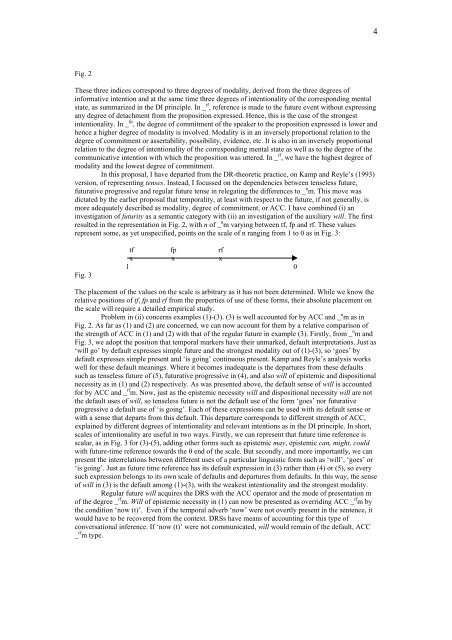SemPrag03.Progr.pdf - Institut für Linguistik/Germanistik - Universität ...
SemPrag03.Progr.pdf - Institut für Linguistik/Germanistik - Universität ...
SemPrag03.Progr.pdf - Institut für Linguistik/Germanistik - Universität ...
You also want an ePaper? Increase the reach of your titles
YUMPU automatically turns print PDFs into web optimized ePapers that Google loves.
4<br />
Fig. 2<br />
These three indices correspond to three degrees of modality, derived from the three degrees of<br />
informative intention and at the same time three degrees of intentionality of the corresponding mental<br />
state, as summarized in the DI principle. In _ tf , reference is made to the future event without expressing<br />
any degree of detachment from the proposition expressed. Hence, this is the case of the strongest<br />
intentionality. In _ fp , the degree of commitment of the speaker to the proposition expressed is lower and<br />
hence a higher degree of modality is involved. Modality is in an inversely proportional relation to the<br />
degree of commitment or assertability, possibility, evidence, etc. It is also in an inversely proportional<br />
relation to the degree of intentionality of the corresponding mental state as well as to the degree of the<br />
communicative intention with which the proposition was uttered. In _ rf , we have the highest degree of<br />
modality and the lowest degree of commitment.<br />
In this proposal, I have departed from the DR-theoretic practice, on Kamp and Reyle’s (1993)<br />
version, of representing tenses. Instead, I focussed on the dependencies between tenseless future,<br />
futurative progressive and regular future tense in relegating the differences to _ n m. This move was<br />
dictated by the earlier proposal that temporality, at least with respect to the future, if not generally, is<br />
more adequately described as modality, degree of commitment, or ACC. I have combined (i) an<br />
investigation of futurity as a semantic category with (ii) an investigation of the auxiliary will. The first<br />
resulted in the representation in Fig. 2, with n of _ n m varying between tf, fp and rf. These values<br />
represent some, as yet unspecified, points on the scale of n ranging from 1 to 0 as in Fig. 3:<br />
Fig. 3<br />
tf fp rf<br />
x x x<br />
1 0<br />
The placement of the values on the scale is arbitrary as it has not been determined. While we know the<br />
relative positions of tf, fp and rf from the properties of use of these forms, their absolute placement on<br />
the scale will require a detailed empirical study.<br />
Problem in (ii) concerns examples (1)-(3). (3) is well accounted for by ACC and _ n m as in<br />
Fig. 2. As far as (1) and (2) are concerned, we can now account for them by a relative comparison of<br />
the strength of ACC in (1) and (2) with that of the regular future in example (3). Firstly, from _ n m and<br />
Fig. 3, we adopt the position that temporal markers have their unmarked, default interpretations. Just as<br />
‘will go’ by default expresses simple future and the strongest modality out of (1)-(3), so ‘goes’ by<br />
default expresses simple present and ‘is going’ continuous present. Kamp and Reyle’s analysis works<br />
well for these default meanings. Where it becomes inadequate is the departures from these defaults<br />
such as tenseless future of (5), futurative progressive in (4), and also will of epistemic and dispositional<br />
necessity as in (1) and (2) respectively. As was presented above, the default sense of will is accounted<br />
for by ACC and _ rf m. Now, just as the epistemic necessity will and dispositional necessity will are not<br />
the default uses of will, so tenseless future is not the default use of the form ‘goes’ nor futurative<br />
progressive a default use of ‘is going’. Each of these expressions can be used with its default sense or<br />
with a sense that departs from this default. This departure corresponds to different strength of ACC,<br />
explained by different degrees of intentionality and relevant intentions as in the DI principle. In short,<br />
scales of intentionality are useful in two ways. Firstly, we can represent that future time reference is<br />
scalar, as in Fig. 3 for (3)-(5), adding other forms such as epistemic may, epistemic can, might, could<br />
with future-time reference towards the 0 end of the scale. But secondly, and more importantly, we can<br />
present the interrelations between different uses of a particular linguistic form such as ‘will’, ‘goes’ or<br />
‘is going’. Just as future time reference has its default expression in (3) rather than (4) or (5), so every<br />
such expression belongs to its own scale of defaults and departures from defaults. In this way, the sense<br />
of will in (3) is the default among (1)-(3), with the weakest intentionality and the strongest modality.<br />
Regular future will acquires the DRS with the ACC operator and the mode of presentation m<br />
of the degree _ rf m. Will of epistemic necessity in (1) can now be presented as overriding ACC _ rf m by<br />
the condition ‘now (t)’. Even if the temporal adverb ‘now’ were not overtly present in the sentence, it<br />
would have to be recovered from the context. DRSs have means of accounting for this type of<br />
conversational inference. If ‘now (t)’ were not communicated, will would remain of the default, ACC<br />
_ rf m type.

















